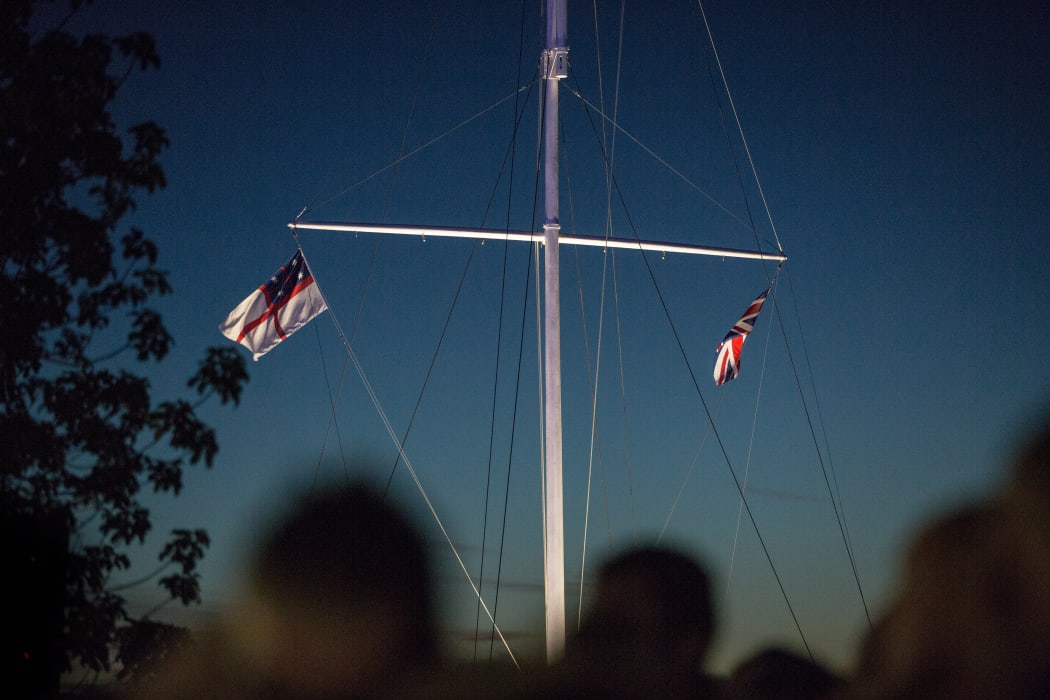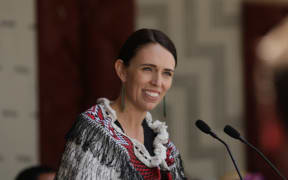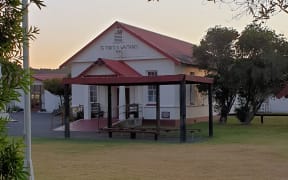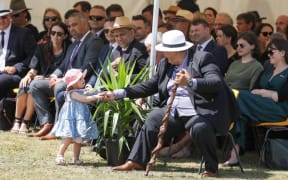By Alexander Gillespie*
Analysis - For a country which had more than 300 years of experience in colonialism, the British decision to annex New Zealand in 1840 was a confused, contradictory, and rushed process that was far from perfect. It was, however, made with good intentions, and from it, the modern nation we now call home emerged.

The flagstaff marks the spot where the Treaty of Waitangi was first signed on 6 February 1840. Photo: RNZ / Cole Eastham-Farrelly
The justifications from London for claiming this land was a mixed bag. They included the state of Māoridom with concerns ranging from some of their practices, which were abhorrent to the modern mind, through to their incessant conflicts, which, with muskets, appeared to be getting worse.
There was also a concern that the British subjects, who were already in New Zealand, were living under no restraint of law or government. Finally, there was concern that a crude, chaotic, and ungoverned type of land-rush via European immigration was about to occur as privately owned, profit-driven organisations, such as the New Zealand Company, aimed to flood the country with settlers.
At the same time, the French were seeking to establish a colony in the South Island. Such uncontrolled trends, they surmised, would be a disaster for the indigenous inhabitants. To solve these problems, in July of 1839, William Hobson was dispatched from London with instructions to take the steps needed to claim this land for Britain.
The decision-makers desired a clear process with integrity so that there would be no doubt under international law about the validity of the annexation, and the colonial competitors (the French) with similar interests in the same space would accept the conclusion.
The obvious difficulty was that the land was already settled with indigenous peoples, who were non-nomadic, and some had already made claims to independence which the British had, in part, accepted in the mid-1830s. This meant that if the British wanted to achieve their goal they had to persuade the leaders of these peoples to voluntarily give their assent to the imposition of colonial rule.
Despite the enormity of the task he was given, Hobson was not given a template drafted by the Home Office in London for a treaty and didn't have skilled lawyers in the area to help him either. After having a national gathering of chiefs arranged at Waitangi in early February, Hobson had to create his own treaty with the assistance of his secretary James Freeman and James Busby, who was in essence the British ambassador in the country before 1840.
The proposed treaty was then translated into Māori by missionary Henry Williams and his son Edward. All of this occurred over four days, with the translation of the Treaty into Māori occurring overnight on 4 February, 1840.
In the preamble of the English version of the Treaty of Waitangi, it was recorded that the Crown was anxious to protect the rights and property of the Māori signatories, and to secure to them "the enjoyment of peace and good order".
This was deemed necessary because of "the great number" of British subjects already there, the foreseen "rapid extension of emigration", and the need to "establish a settled form of civil government with a view to avert the evil consequences which must result from the absence of the necessary laws and institutions" and of detriment to both Māori and European alike.
Accordingly, the English preamble recorded that the Queen had sent a representative to acquire 'sovereign authority over the whole or any part of those islands'. Conversely, while the Māori version of the preamble recorded the goal of the British Crown, the importance of securing tribal rangatiratanga and Māori land ownership, for as long as they wished to retain it, was much clearer.
The English version of the First article of the Treaty related to the ultimate control and power of the country. This article recorded the chiefs ceding to the Crown "absolutely and without reservation all the rights and powers of Sovereignty which the said Confederation or Individual Chiefs respectively exercise or possess, or may be supposed to exercise or to possess over their respective Territories as the sole sovereigns thereof."
In the Māori version of the First article, the word 'sovereignty' had no direct translation. This is not a surprise, because the idea of national sovereignty would have been difficult to comprehend. Chiefs had authority over their own areas but there was no central ruler over the country. Accordingly, the translators of the English text used the Māori word 'kawanatanga', an abstraction from the word kawana, itself a transliteration of 'governor' and hence meant 'governorship'.
Although this may have been correct in one sense, in another, the depth of the national sovereignty the British were claiming was probably not what the chiefs thought they were agreeing to. Had the Māori signatories been told that the Queen's authority would be absolute, or the Māori laws only valid for as long as the Queen wanted them, and that they were not to be equal in the decision-making processes, it is doubtful they would have signed in 1840.
The Second article in the English version of the Treaty dealt more with the authority and rights that each signatory had at the local (as opposed to national, sovereign) level. It stated: "onfirmed and guarantees to the Chiefs and Tribes of New Zealand and to the respective families and individuals thereof the full exclusive and undisturbed possession of their Lands and Estates Forests Fisheries and other properties which they may collectively or individually possess so long as it is their wish and desire to retain the same in their possession."
In return, the Chiefs yielded to the Crown "the exclusive right of pre-emption over such lands as the proprietors thereof may be disposed to alienate at such prices as may be agreed upon between the owners and the agents of the Crown."
In the Māori text of the Second article, Māori were guaranteed 'te tino rangatiratanga', or the unqualified exercise of their chieftainship, over their lands, villages, and all their property and treasures. This was more than was offered in English of the 'full exclusive and undisturbed possession of their lands and estates, forests, fisheries and other properties'.
Accordingly, some would see 'tino rangatiratanga' as the treaty guaranteeing Māori the right to continue to manage and govern their own affairs without interference by a civil or military authority. In addition, although they agreed to give the Crown the right to buy their land if they wished to sell it, it is not certain if the Māori text clearly conveyed the implications of exclusive Crown purchase.
The Third article of the Treaty is the least controversial. While the English version had the Crown promise the Māori signatories 'her royal protection and imparts to them all the Rights and Privileges of British Subjects', the Māori text mirrored that the Crown gave an assurance that Māori would have the Queen's protection and all rights (tikanga) accorded to British subjects.
The postscript to the treaty had the signatories pledge that they understood fully the provisions of the document and entered into in "the same in the full spirit and meaning thereof".
After a five-hour deliberation on 5 February, followed by further debate into the night, a consensus for the 45 chiefs present was reached. This consensus allowed for the Treaty of Waitangi to be signed on 6 February, 1840. As the chiefs who signed the Treaty were predominantly from the Bay of Islands area, Hobson sought to get a more extensive collection of signatures. Eight copies of the Treaty were then prepared and taken about by missionaries and officials.
Five-hundred-and-twelve signatures were obtained from 50 different locations, including some from the South Island, by 3 September, 1840. Many of these signatories probably saw the Treaty in a positive light, in which they were giving up very little. Nōpera Panakareao's statement, after signing the document, that "the shadow of the land goes to Queen Victoria, but the substance remains to us" was probably the understanding of many. Others signed for what they believed were the benefits of British authority and colonialism.
Others refused to sign at all, vowing never to consent, likening it to slavery, and returning the gifts of blankets in the process. There were some parts of the country where there was substantial non-adherence by Māori leaders who coveted their independence.
On 21 May, 1840, Hobson declared that sovereignty had been obtained by cession over the North Island, by virtue of the Treaty of Waitangi. With the second proclamation on 5 June, Hobson claimed sovereignty over the South Island and Stewart Island by right of discovery, but without reference to the Treaty of Waitangi.
Just over two weeks later on 16 June, 1840, an Act of the Legislative Council of New South Wales annexed New Zealand to the Government of New South Wales. These Proclamations were then Gazetted in London on 2 October, 1840. From that date, all other European powers were on notice that New Zealand was now part of the British family.
*Alexander Gillespie is a law professor at the University of Waikato.




